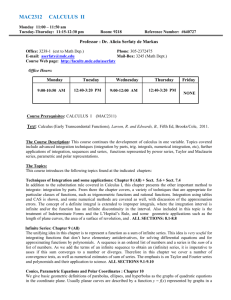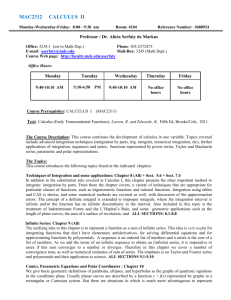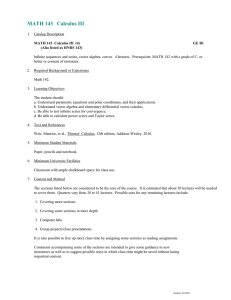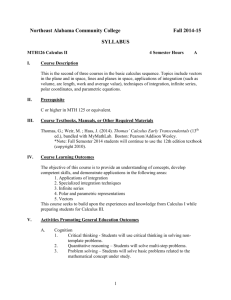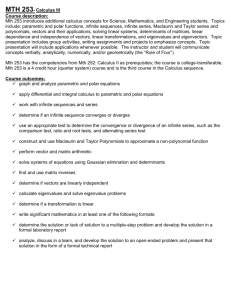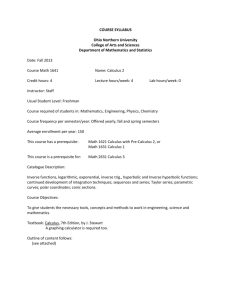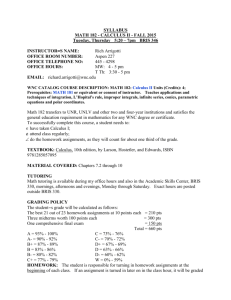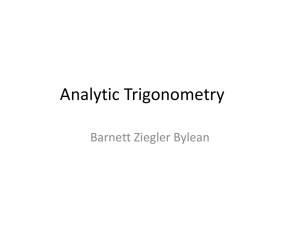On-Campus support - MDC Faculty Home Pages
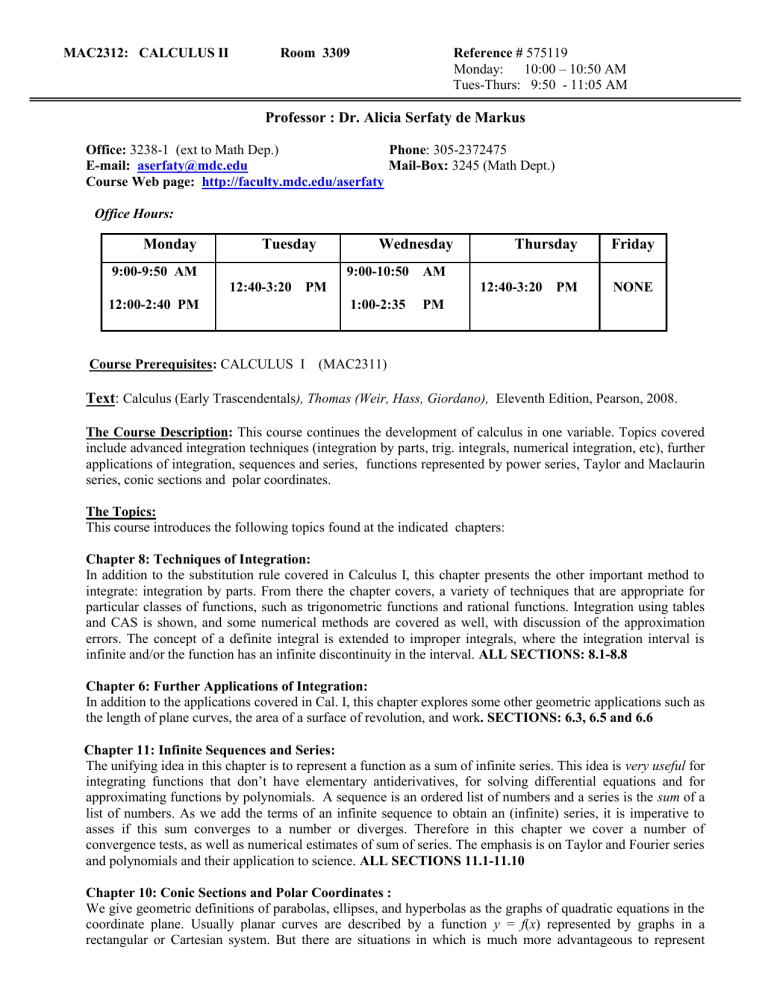
MAC2312: CALCULUS II Room 3309 Reference # 575119
Monday: 10:00 – 10:50 AM
Tues-Thurs: 9:50 - 11:05 AM
Professor : Dr. Alicia Serfaty de Markus
Office: 3238-1 (ext to Math Dep.) Phone : 305-2372475
E-mail: aserfaty@mdc.edu
Mail-Box: 3245 (Math Dept.)
Course Web page: http://faculty.mdc.edu/aserfaty
Office Hours:
Monday Tuesday Wednesday Thursday Friday
9:00-9:50 AM
12:40-3:20 PM
9:00-10:50 AM
12:40-3:20 PM NONE
12:00-2:40 PM 1:00-2:35 PM
Course Prerequisites: CALCULUS I (MAC2311)
Text
: Calculus (Early Trascendentals ), Thomas (Weir, Hass, Giordano), Eleventh Edition, Pearson, 2008.
The Course Description: This course continues the development of calculus in one variable. Topics covered include advanced integration techniques (integration by parts, trig. integrals, numerical integration, etc), further applications of integration, sequences and series, functions represented by power series, Taylor and Maclaurin series, conic sections and polar coordinates.
The Topics:
This course introduces the following topics found at the indicated chapters:
Chapter 8: Techniques of Integration:
In addition to the substitution rule covered in Calculus I, this chapter presents the other important method to integrate: integration by parts. From there the chapter covers, a variety of techniques that are appropriate for particular classes of functions, such as trigonometric functions and rational functions. Integration using tables and CAS is shown, and some numerical methods are covered as well, with discussion of the approximation errors. The concept of a definite integral is extended to improper integrals, where the integration interval is infinite and/or the function has an infinite discontinuity in the interval. ALL SECTIONS: 8.1-8.8
Chapter 6: Further Applications of Integration:
In addition to the applications covered in Cal. I, this chapter explores some other geometric applications such as the length of plane curves, the area of a surface of revolution, and work . SECTIONS: 6.3, 6.5 and 6.6
Chapter 11: Infinite Sequences and Series:
The unifying idea in this chapter is to represent a function as a sum of infinite series. This idea is very useful for integrating functions that don’t have elementary antiderivatives, for solving differential equations and for approximating functions by polynomials. A sequence is an ordered list of numbers and a series is the sum of a list of numbers. As we add the terms of an infinite sequence to obtain an (infinite) series, it is imperative to asses if this sum converges to a number or diverges. Therefore in this chapter we cover a number of convergence tests, as well as numerical estimates of sum of series. The emphasis is on Taylor and Fourier series and polynomials and their application to science. ALL SECTIONS 11.1-11.10
Chapter 10: Conic Sections and Polar Coordinates :
We give geometric definitions of parabolas, ellipses, and hyperbolas as the graphs of quadratic equations in the coordinate plane. Usually planar curves are described by a function y = f ( x ) represented by graphs in a rectangular or Cartesian system. But there are situations in which is much more advantageous to represent
certain curves (ellipses, cycloids, roses, etc) in a different system. In this chapter we discuss two coordinates systems for describing curves: parametric and polar system. In the parametric system both x and y are given in terms of a third variable t called a parameter. In the polar coordinate system a point ( x, y ) is represented by coordinates ( r ,
) where r is a distance from the origin and
is the angle respect to a line called the polar axis
Additional topics may be included at the instructor‘s discretion.
(where the origin is located). The methods of calculus are applied to these parametric or polar curves to find tangents, areas, arc length and surface area. SECTIONS 3.5, 10.1, 10.4 and 10.5
Attendance: Class lectures, discussions and exercises sessions are considered to be crucial to succeed in this course. Attendance is mandatory, and will be recorded for administrative purposes every class session. If you miss more than 3 classes, you may be purged from the course. It is your responsibility to attend each lecture and keep records of assignments and other information delivered during class. If you cannot attend class, it is a common courtesy to email me or leave me a phone message. Because of the number of students in all of the Professor’s classes, it is not possible to personally inform each absent student of the material that is missed due to an absence, or the corresponding assignment. For this reason, please have the name and phone number of at least one other student in the class that you can call and ask for missed lecture notes and assignments
Classroom decorum: In order to optimize your learning experience, classroom interruption must be kept to a minimum. Please make every effort to arrive on time and avoid causing an interruption if you need to leave early.
Please turn your cell phone to a silent mode and avoid using it during class. In an emergency, you may excuse yourself and leave the classroom.
Academic dishonesty: Any instance of academic dishonesty will result in a grade of F for the course and can carry an even more severe penalty such as suspension or expulsion. Take pride in your own achievements, an unearned passing grade is not worth the paper it is written on
.
A Scientific Calculator: Students are required to bring and use a scientific calculator to class in this course.
The tests:
The most likely dates of our four tests will be after completion of groups of selected topics from chapters 1-5 as outlined below. Please check regularly our web page for updates on dates and precise content of the tests :
Test 1: on topics from chapter 8
Test 2: on topics from chapter 8 and chapter 6.
Test 3: on topics from chapter 11
Test 4: on topics from chapter 11 and 10
Final: Comprehensive (that is: ALL).
Please note: Specific dates and topics will be announced in class and posted in the Professor’s web site, and altered at the discretion of the Professor. It is your responsibility to verify dates and topics.
Grading Policies: Your final grade will be based on:
four tests (15 % each)
The Final Exam (comprehensive and mandatory) (20%)
1-2 projects (20 %)
There are no make up tests: If you miss a test, the Final Exam will replace one score. The Final Exam is the only make-up exam.
If you have not missed any test, the Final Exam might replace your lowest test score.
A student’s final grade may be raised above her or his earned percentage if in the Professor’s opinion the student shows significantly sustained effort and improved scores in the course or on the comprehensive final exam or through other activities. The Professor will specially consider:
Homework
: Practice exercises will be assigned frequently and posted in the Professor’s web site and by means of handouts. Although optional , homework will help the Professor decide a final grade in a borderline situation, therefore homework should be submitted towards the end of the course in a separate notebook. All written work should be neat, organized, and should show sufficiently many steps to demonstrate a clear understanding of the techniques used.
Participation.
Attendance
The System of Evaluation:
Every test will consist of a number of multiple choice questions. Also, short answer, open ended and/or applications problems may be asked, where all work must show sufficiently many steps to describe the procedure used to solve the problem(s), so partial credit can be earned .
A grade – 90% and above
B grade – between 80% and 89%
C grade – between 65% and 79%
D grade – between 40% and 64%
F grade – below 40%
In very extreme circumstances, you may request a grade of I (incomplete) only if you are passing the class and have completed the course past the last date to drop the course with a W.
On-Campus support
The Math/Science Study Center, located in room 3326, is available to you as additional support for your academic needs. Its operating hours are:
Monday – Thursday: 9:00 AM – 9:00 PM
Friday: 9:00 AM – 3:00 PM
Saturday: 9:00 AM – 12:00 Noon
Important Dates :
Last day to change courses with a 100% refund: Friday August 27.
Last day to withdraw with grade of W: Tuesday November 2.
Last day of classes: Friday December 10.
Last day finals exams: Friday December 17.
Holidays – Monday September 6, Thursday November 11, Thursday November 25 and Friday November
26.
